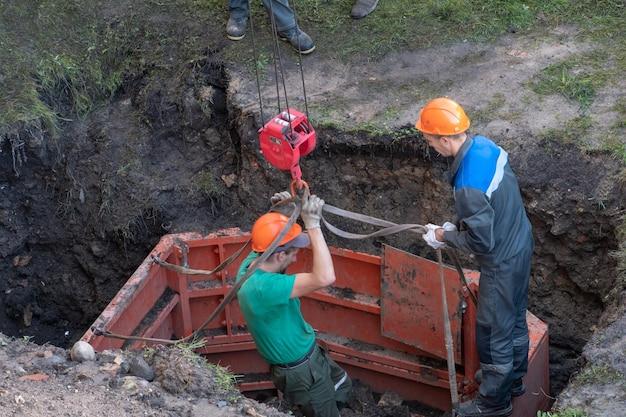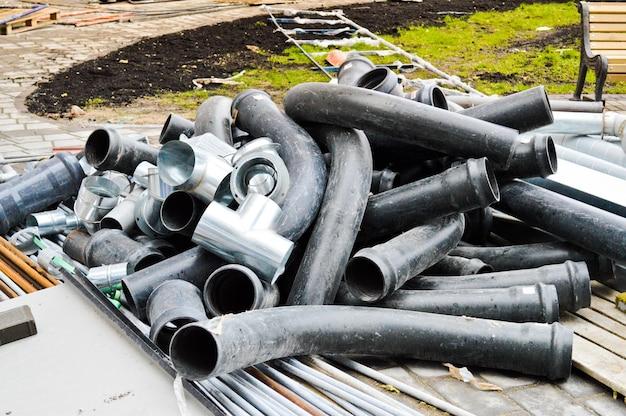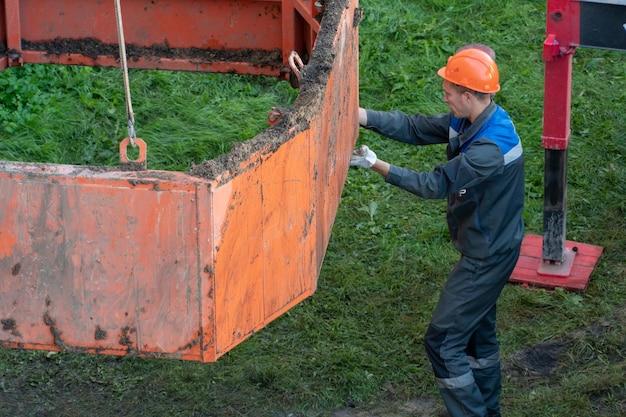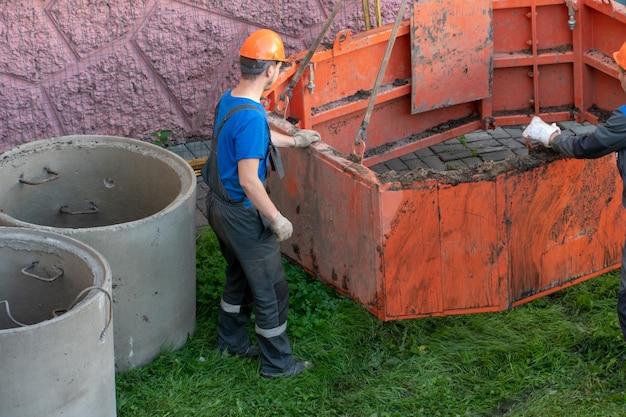Are you experiencing leaks or clogs in your water line that often lead to costly repairs and unsightly digging in your yard? Say goodbye to these old-school methods and say hello to trenchless water pipe replacement. With the help of trenchless technology, you can fix your water line without excessive digging, resulting in a more cost-effective and eco-friendly solution.
But what exactly is trenchless water line replacement, you ask? How does it work? Keep reading as we answer these questions and more, while also discussing its benefits and potential downsides. We’ll even break down the costs associated with replacing a water line from the street to your house, so you’ll know what to expect.
So, whether you’re a homeowner or a business owner looking for a modern approach to fixing your water line, this blog post will give you an insider’s look at how trenchless pipe lining works and its potential drawbacks. In addition, we’ll explore alternative methods to underground water line replacement and how they differ from trenchless technology. Let’s dive in!
The Benefits of Trenchless Water Pipe Replacement
If you’re dealing with water pipe issues, you might think the only solution involves digging up your yard and replacing the damaged pipes. However, there’s now a faster, cleaner, and more affordable method of addressing this problem: trenchless water pipe replacement.
Here are the benefits of trenchless water pipe replacement:
Faster Installation
With trenchless water pipe replacement, there’s no need to dig trenches for new pipes, which speeds up the installation process significantly. Contractors use techniques such as pipe bursting or directional drilling to replace old pipes with new ones underground, without disturbing the surface. Therefore, you’ll have water flowing through your pipes in no time.
Less Invasive
Trenchless water pipe replacement is less invasive to your property. The old way of replacing water pipes involved digging up trenches, uprooting trees and destroying your landscape. But with trenchless technology, there’s no need for extensive digging that can ruin your yard. Contractors only need to dig small access holes to access the damaged pipes.
More Affordable
Trenchless water pipe replacement technology is more affordable than the traditional method. That’s because the old way involves a lot of time-consuming excavation work that inflates the total cost of the project. With trenchless water pipe replacement, contractors work faster and take less time to complete the project, which translates to overall cost savings.
Durable and Long-Lasting
Trenchless water pipe replacement technology uses pipes made of high-density polyethylene material, which is durable, long-lasting and corrosion-resistant. This means that once you have these pipes installed, they will last for decades, giving you peace of mind that you won’t have to deal with water pipe issues again anytime soon.
Environmentally-Friendly
Trenchless water pipe replacement is an eco-friendly solution since it involves less digging and excavation. This means that there’ll be fewer carbon emissions from the heavy machinery used to dig up trenches. Additionally, this method doesn’t require any chemicals that may leach into the groundwater and pollute the environment.
In conclusion, trenchless water pipe replacement is a faster, less invasive, more affordable, durable, and environmentally-friendly solution to your water pipe issues. If you’re considering replacing your water pipes, trenchless technology offers an excellent alternative that will help you avoid the messy and costly traditional excavation method.
Trenchless Water Line Puller
Trenchless water line puller is a modern technology that has revolutionized water line replacement. It involves pulling a new pipe through an existing pipe without digging a trench, which minimizes disturbance to the surrounding environment. This subsection will cover trenchless water line puller and how it works.
How it Works
Trenchless water line puller is a simple yet effective process that is carried out using specialized equipment. The first step is to assess the condition of the existing pipe using a camera inspection system. If the existing pipe is in good condition, the next step is to remove any obstruction within the pipe that could interfere with the pulling process. Once this is done, a new pipe is attached to the puller and inserted into the existing pipe.
As the puller moves forward, it pulls the new pipe along with it, effectively replacing the old pipe. The new pipe is made of high-density polyethylene (HDPE), which is a strong, durable, and long-lasting material that can withstand harsh environments.
Benefits of Trenchless Water Line Puller
Trenchless water line puller offers numerous advantages over traditional pipe replacement methods. Some of these benefits include:
- Minimal disturbance to the surrounding environment
- Faster installation time
- Reduced cost and labor
- Minimal damage to landscaping and infrastructure
- Long-lasting solution
In conclusion, trenchless water line puller is a modern and effective technology that has revolutionized water line replacement. It offers a fast, cost-effective, and reliable alternative to traditional pipe replacement methods. If you’re planning to replace your water pipe, consider trenchless water line puller as your preferred option.
What is Trenchless Waterline
Trenchless waterline is a method of repairing or replacing underground water pipes without having to dig up the entire pipe. It is also known as trenchless water pipe replacement. This method is becoming more popular because it is less disruptive and less costly than traditional pipe repair methods.
How Does Trenchless Waterline Work
The trenchless waterline replacement process involves using specialized equipment to bore or tunnel through the ground to access the damaged water pipe. There are two main types of trenchless waterline replacement methods:
Pipe Lining
This method involves inserting a flexible resin or epoxy liner into the damaged pipe. The liner is then inflated and cured in place, creating a new pipe within the existing damaged pipe.
Pipe Bursting
This method involves breaking apart the old pipe and pulling a new pipe through the ground using a hydraulic pulley or winch. This method is suitable for larger diameter pipes or pipes that are severely damaged.
Advantages of Trenchless Waterline
There are several advantages of trenchless waterline replacement, including:
- Less disruption to the surrounding area
- Less excavation and dirt removal
- Faster repair or replacement time
- Cost-effective
- Durable and long-lasting
- Environmentally friendly
Trenchless waterline replacement is a cost-effective and efficient method of repairing or replacing damaged underground water pipes. By opting for this method, homeowners and businesses can avoid the disruption and expense associated with traditional pipe repair methods.
Underground Water Line Replacement
If your property is experiencing leaks or other issues with its underground water line, it’s essential to carry out repairs as soon as possible. Sometimes, simple repairs are enough to fix the problem, but in many cases, replacement is necessary. Here’s what you need to know about underground water line replacement:
Signs That You Need Underground Water Line Replacement
The first step in fixing your water line is identifying the problem. Common signs that indicate you need a replacement include low water pressure, soil erosion around the property, sinkholes, or water discoloration. If you notice any of these symptoms, it’s essential to call in a professional plumber for an assessment.
Types of Water Line Replacement
There are two main types of water line replacements: traditional and trenchless. Traditional replacement involves digging up the entire length of the water line and replacing it with a new pipe. Trenchless water line replacement, on the other hand, is a less invasive process that involves minimal digging. Instead, a new pipe is installed inside the existing pipe. Trenchless replacement is faster, less disruptive, and generally more cost-effective than traditional replacement.
Steps Involved in Underground Water Line Replacement
The first step in any underground water line replacement is to locate the damaged section of the pipe. Once this is done, the affected area is excavated, and the old pipe is removed. If you’re using trenchless technology, a new pipe is inserted into the old one and expanded until it fits snugly. The last step is to test the new pipe to ensure that there are no leaks.
Underground water line replacement is a complex process that should only be carried out by experienced professionals. Traditional replacement can be time-consuming and expensive, while trenchless replacement is faster, less disruptive, and more efficient. Remember to keep an eye out for signs that indicate you need a replacement so that you can address the issue before it becomes a more significant problem.
How Trenchless Pipe Lining Is Done
Trenchless pipe lining is a modern technique for repairing damaged water pipes without the need to dig up the surrounding soil. It’s a fascinating process that utilizes the latest technology and tools to make the procedure faster, cleaner, and more cost-effective than traditional excavation methods. Here’s how trenchless pipe lining is done:
Inspection
Before any work can start, the plumbing team will need to inspect your water pipes thoroughly. This inspection helps them identify the plumbing problem, assess the extent of the damage, and determine the best way to proceed with the repair work. They will use special cameras to get a close-up look at the pipes’ interiors and identify any cracks, blockages, or other issues.
Cleaning
Once the inspection is complete, the team will use hydro jetting to clean your pipes thoroughly. This process involves the use of high-pressure water to blast away all the debris, rust, and build-up inside the pipe walls. This clears the way for the new liner and ensures optimal adhesion to the old pipe.
Lining
The trenchless lining process involves inserting a flexible resin liner into the existing pipe. The liner is impregnated with a 2-part epoxy resin and fed into the pipe via a special hose. Once in place, the team inflates the liner with air, allowing the epoxy to bond to the old pipe’s interior surface. The resin liner then hardens and creates a new, seamless pipe within the old one that is stronger and more durable.
Curing
After the liner is in place, the system is cured using either hot water or steam. The curing process takes about 2-3 hours, and during this time, the epoxy resin hardens, creating a smooth and durable new pipe interior. The curing process is monitored closely to ensure optimal adhesion and a uniform liner thickness.
Inspection and Testing
Finally, the team will conduct a post-lining inspection, using cameras to inspect the newly lined pipe. Any issues or concerns will be addressed at this point and repaired before the project is considered complete. Additional testing may also be conducted to ensure that the new pipe is functioning correctly and meeting all municipal codes and standards.
In conclusion, trenchless pipe lining is a cutting-edge technology that offers a faster, cleaner, and more cost-effective solution to repairing water pipes. If you’re experiencing plumbing issues or suspect a problem with your water pipes, don’t hesitate to contact a professional plumbing service that offers trenchless pipe lining services.
Water Line from Street to House Cost
If you’ve experienced a water leak, low pressure, or discolored water, you might have a problem with your water line from street to house. Fixing this problem can be difficult, time-consuming, and costly. In this section, I’ll discuss the key factors that will determine the cost of replacing or repairing a water line from the street to your house.
Factors that Affect the Cost
Several factors will determine the price of fixing a water line from the street to your house. Firstly, the length of the pipe that requires replacement or repair will significantly affect the cost. Longer pipes will cost more than shorter ones. The depth of the line also plays a significant role in determining the cost. The deeper the line, the higher the cost, as more excavation will be required.
Another essential factor that will affect the cost is the material of the water lines. Old houses usually have galvanized iron pipes, which are cheaper than modern materials such as copper and PVC. The age of the pipes will also determine the cost. Older pipes are more prone to damage, and therefore, may be more expensive to fix.
Repair or Replacement
You can either opt to repair or replace your water line from the street to your house. If the issue is minor, which means that the leak is small, then repairing the pipe may be feasible. On the other hand, if the pipe is old or severely damaged, replacing the entire line may be the best option.
Estimated Cost
The cost of repairing or replacing a water line from the street to your house varies depending on the factors listed above. A typical water line replacement may cost anywhere between $1,500 to $5,000, while repairs may cost between $500 and $1,000. It’s crucial to remember that these are just estimates, and the actual cost may be higher or lower.
Fixing a water line from the street to your house is a costly affair and requires professional help. Ensure that you find a reputable contractor who has the experience and the necessary equipment to do the job correctly. Don’t try to do it yourself, as you might end up causing more damage and increasing the total cost.
The Disadvantages of Trenchless Pipe Lining
Trenchless pipe lining has been a popular solution for replacing damaged pipelines. But, like any other method, it has its own set of disadvantages that we need to explore.
Limited Lifespan
Trenchless pipe lining may not last as long as other replacement methods. Although cheaper in the short term, it can cause significant problems in the long term. In the event of a blockage or root intrusion, it may not be possible to clear the line without destroying the lining. This means that the entire operation will have to be repeated, resulting in additional expenses and inconvenience.
Limited Availability
Trenchless pipe lining technology is not readily available in all regions. The equipment and materials required for this method may not be available everywhere, making it difficult to find technicians or contractors who specialize in trenchless pipe lining.
Limited Applicability
Trenchless pipe lining may not be effective in all situations. The technique may not be effective if the pipes are severely damaged or have collapsed. In some cases, digging may be the only option.
Limited Inspection Capabilities
Trenchless pipe lining may not offer sufficient inspection capabilities. Unlike traditional pipe replacement methods, which allow for visual inspection of a pipe during the process of replacement, trenchless pipe lining does not offer the same level of visibility. This means that the contractor cannot visually confirm the quality of the installation.
Limited Long-Term Warranty
Many trenchless pipe lining manufacturers only offer a limited long-term warranty, usually around 10 years. This may not provide the level of coverage needed for a long-term investment.
Although trenchless pipe lining is an excellent method for replacing damaged pipelines, it is not without its disadvantages. It is essential to consider all aspects of the project before settling for this method. Nonetheless, when used appropriately, trenchless pipe lining can be cost-effective, time-saving, and environmentally friendly.
How do you run a pipe underground without digging it
Running a pipe underground without digging it is possible with a technique called trenchless water pipe replacement. It involves inserting a new pipe into the existing one, with minimal excavation, making it a cost-effective, time-saving, and less intrusive method of pipe installation.
What is Trenchless Water Pipe Replacement
Trenchless water pipe replacement is a way of replacing pipes without digging trenches. This approach utilizes advanced technology, such as pipe bursting, slip lining, and directional drilling, which makes it possible to repair, replace, and install water pipes with minimal excavation, disruption, and environmental impact.
Pipe Bursting
Pipe bursting involves fracturing the old pipe and pulling in new pipes. It is an efficient method of trenchless water pipe replacement, which entails the use of hydraulic jacks to fracture the old pipe and pull in the new pipe. This method allows the replacement of pipes ranging from 1 inch to 16 inches in diameter.
Slip Lining
Slip lining involves inserting a new pipe inside the damaged or existing pipe. The new pipe is made of plastic, metal, or fiberglass and is slightly smaller than the existing pipe. It is then pulled through the old pipe to create a lined pipe. Slip lining is cost-effective and involves minimum excavation.
Directional Drilling
Directional drilling involves directional boring or horizontal directional drilling (HDD), which involves drilling a pilot hole along the path of the new pipe to be installed. Steel drill rods are then inserted into the pilot hole, and a reamer is used to enlarge the hole to the required diameter to insert the new pipe.
Trenchless water pipe replacement is an efficient and viable option when it comes to underground pipe installation, repair and replacement. With minimal excavation, the technique is eco-friendly, faster, and cost-effective, ensuring minimal disruption in infrastructure, the environment, and people’s daily lives. Contact a professional plumber or trenchless pipe replacement expert near you to explore trenchless water pipe replacement as an alternative to traditional pipe installation methods.



